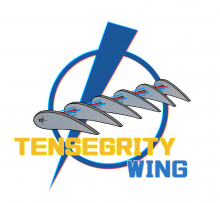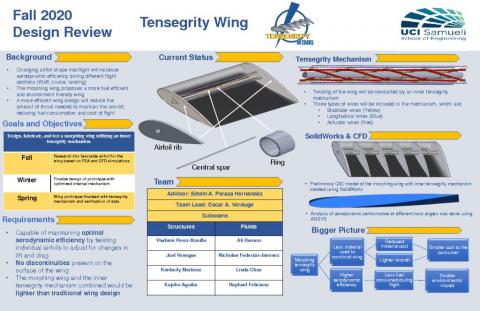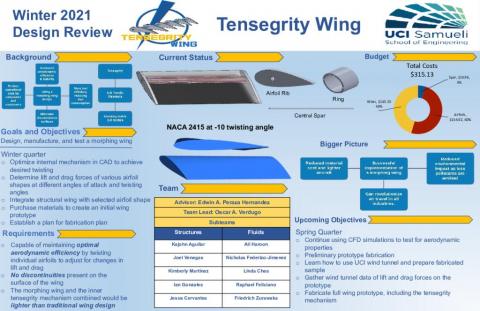Tensegrity Wing
Background
Tensegrity structures are combinations of 1D members and rigid or flexible bodies that utilize adjustable tension to control the shape or stiffness of a structure, and have shown to achieve characteristics such as having load-bearing and energy absorption capabilities using minimum mass. By using a tensegrity wing structure, the airfoil shape of the wing can be changed on demand, giving the wing a greater range of mobility. By having greater mobility, it is predicted that a tensegrity wing structure would be able to achieve higher aerodynamic efficiencies than convectional wing control surfaces. Different flight sections (liftoff, cruising, and landing) produce different lift and drag properties due to the angle of attack changes, therefore a tensegrity wing would be able to combat these changes. By creating a wing with higher aerodynamic efficiency properties and reduced overall weight, fuel consumption and manufacturing cost can be decreased, which can result in lower flight cost for the common person.
Goals
The goal for the 2020-21 Tensegrity Wing team is to design, manufacture, and test a fully functional morphing wing enabled by an internal tensegrity mechanism.
Objectives
Based on previous projects and research done by last year's team, the 2020-21 team has decided to go forward with a twisting wing design, and have set the following objectives.
Fall Quarter (2020):
- Run CFD simulations on selective airfoils with the twisting wing design and the conventional wing design, then compare the max lift and drag coefficient data versus angle of attack of both designs in order to select the most favorable airfoil shape for the tensegrity wing project.
- Design a CAD model for a functional prototype, including a moving 3D CAD model simulation of the twisting tower mechanism.
Winter Quarter (2021):
- CFD subteam will continue running more CFD simulations so that we would have a larger pools of airfoils to do comparison and pick the most favorable airfoil. Once an airfoil is chosen, the Structural subteam will apply it to the CAD model.
- The Structural Subteam will also work on researching and selecting materials that will allow the twisting wing to perform best along with the twisting tower mechanism. If possible, we hope to start the fabrication of tensegrity wing.
Team Contacts
Advisor: Edwin A. Peraza Hernandez <eperazah@uci.edu>
Team Lead: Oscar Verdugo <overdugo@uci.edu>



